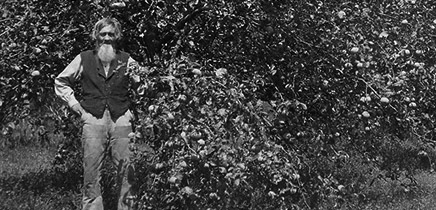“Stretching across the varied landscapes of metropolitan and rural Minnesota, the Luce Line is a preserved strip of countryside alive with many varieties of plants and animals. In the east the influence is woodland, a carry-over from the Big Woods that once occupied the area. Rolling stands of sugar maple and basswood, along with many colorful forest floor ground-cover plants can be found here. From Hutchinson westward, the Big Woods gives way to remnants of the tall-grass prairie, with many prairie plants still visible [. . .] The Luce Line is truly like a jaunt down a quiet country road.” ~Luce Line State Trail, DNR website
The history of the Luce Line State Trail begins with William Luce back in 1908. That year, Luce started the Electric Short Line Railroad Company, with a planned route from Minneapolis/St. Paul to Montevideo. Construction started and stopped many times over the years, as funding came and went. Funds ran out completely in 1927, making the terminus of the line at Gluek, 12 miles shy of the originally planned terminus.
In 1927, the Luce’s renamed the company the Minnesota Western Railroad Co., though shortly after it was sold to the Minnesota Northfield and Southern Railroad. Over the years, the track changed hands a few more times. First, it was absorbed by the Minneapolis and St. Louis Railroad in 1956, then the Chicago and North Western in 1960. This route was only a passenger route for the first few years, but later a freight route for most of its history. Clients along this railway included granaries, mills, and canning companies. In Carver County, a valuable client was the Minnesota Valley Canning Factory, later Green Giant. Stations along the route included Hazelton and Hollywood stations in Carver County.
By the 1970s, rail transport was being put out of business by other modes of transportation, such as semi-trailer and air-freight. As this happened, former railway tracks were abandoned. The Luce Line railroad track was officially abandoned in 1972. This was around the time that interest was sparked in other uses for the trail, most significantly as a walking/hiking route. In 1973, the Minnesota state Legislature passed legislation authorizing the Luce Line as a state trail. A Luce Line Trail Association was formed in 1973 to raise funds for a feasibility study on converting the trail. The group raised $14,000 and the study was completed the same year. By 1975, interest peaked. That year, the Minnesota Department of Natural Resources acquired large portions of the trail through federal and state funding.
The Luce Line State Trail opened in the late 1970s. It was the first trail in the United States converted from rail to a multi-use trail. This meant that rather than just walking, the trail also accomadated jogging, hiking, biking, skiing, horseback riding and snowmobiling. During that time, much work was done by the DNR. A master plan was completed in 1978. Walking and horse trails were graded side by side. The route from Stubbs Bay, lake Minnetonka to Watertown was surfaced in limestone in 1977. From Watertown to Winsted was surfaced in limestone in 1980. The rest of the trails beds were converted to gravel or mown grass.
During this time, the Luce Line Trail was not free of controversy. Landowners along the trail objected, saying that with the railway gone, ownership should revert to landowners not the DNR. Objections culminated in a U.S. supreme Court decision in 1988 which stated “that recreational trail use was a bona fide public transportation use of rail corridors, and the rights-of-way are therefore not subject to reversion to adjoining landowners.” Despite this ruling, objections continued, leading the Legislature to direct the DNR to sell the western 38 miles back to the adjoining landowners, shortening the final trail to 63 miles.
In 1994, a second Luce Line Trail Association was formed, with the mission of repair and improvement along the trail through the lobbying of state funding. The group also worked with the DNR to start an Adopt-a-Trail along the Luce Line. Sponsors were responsible for keeping their section free of litter, keeping an eye on trail conditions, and performing routine light maintenance.
In the twenty-first century, the Luce Line Trail consists of 1,000 acres and 63 miles. It is popular among enthusiasts of all sorts, from walking to biking. In Carver County, the city of Watertown hosts a popular Rails-to-Trails event each year. This annual celebration began in 1993 and remains a popular festival, with the Golden Spikes Treasure Hunt and a 5k run being annual events. It is held at or near the Luce Line Trail walking bridge located in Watertown each year.
Betts, Lynn, as told to Margaret Davis. “History of the Luce Line and the First Start of the Original Luce Line Trail Organization.” Luce Line Express, 4 no. 3 (October 1997). Subject Files, Drawer G1: Luce Line. Carver County Historical Society Research Library.
Centennial Book Committee. “Luce Line.” Winsted Centennial. Winsted Telephone co., 1986.
“Looking Back at the Luce Line History.” Winsted Journal, March 25, 1997.
Luce Line State Trail website. “History of the Trail.” Accessed August 5, 2014. http://luceline.com/history/
http://luceline.com/history/the-trail-itself/
http://luceline.com/history/luce-line-railroad/
Minnesota Department of Natural Resources website. “Luce Line State Trail.” Accessed August 5, 2014. http://www.dnr.state.mn.us/state_trails/luce_line/index.html
Peterson, George. “Sentimental Jaunt Along an Abandoned Rail Line.” Minneapolis Tribune, August 13, 1972.
Raconteur, Ivan. “Luce Line- One Trail, Many Uses.” Herald Journal, April 9, 2007. http://www.herald-journal.com/archives/2007/stories/luceline.html
Rails to Trails event brochure. Subject Files, Drawer G1: Rails to Trails- Watertown celebration. Carver County Historical Society Research Library.
Rails to Trails website. Accessed August 5, 2014. http://www.railstotrails.ws/
Samstad, Lawrence E., et. al. “An Evaluation of the Luce Line Railroad as a Recreational Trail System from Wayzata to Gluek, Minnesota.” Engineering feasibility study. Itasca Engineering, Inc.: May 1, 1973.
Sebora, Jenni. “Enjoy the Luce Line Trail.” Herald Journal, September 25, 2006.
“Watertown Gets First Train in 1915.” Watertown Centennial: 1856 . . .1956. Watertown, MN: Watertown Activities, Inc., 1956.


